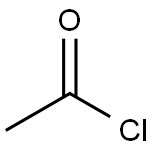-
外観
無色澄明の液体
-
性質
塩化アセチルの密度は1.105g/cm3であり、融点は−112°C、沸点は51°Cです。常温では、引火性や可燃性を持つ無色の液体です。
塩化アセチルには不快な刺激臭が特徴で、目や皮膚への刺激性があります。、、エーテル、石油エーテルに可溶です。
なお、塩化アセチルはカルボン酸塩化物です。アセチルとは、化学式がCH3CO-で表されるアシル基のことを指します。塩化アセチルの分子式はC2H3ClOで表され、分子量は78.50です。
-
溶解性
水, アルコールに分解。エーテルに易溶。水又はエタノールと激しく反応して分解する。
-
解説
塩化アセチル,えんかあせちる,酢酸の酸塩化物。化学式CH3COCl,沸点50.9℃の無色の液体で,湿った空気中では発煙する。不快臭を有し目を刺激する。水と激しく反応して,酢酸と塩酸に加水分解する。アセチル化剤として有用で,第一および第二アミンと反応してアセトアミド類を生成し,またアルコールとの反応では酢酸エステルを与える。芳香環に対してはフリーデル=クラフツ反応によりアセトフェノン誘導体を与える。塩化アセチルは,酢酸に塩化チオニルSOCl2や三塩化リンなどを作用すると得られるが,実験室的に最も簡便な合成法は無水酢酸と塩化カルシウムとの反応である。芳香環に対してはフリーデル=クラフツ反応によりアセトフェノン誘導体を与える。塩化アセチルは,酢酸に塩化チオニルSOCl2や三塩化リンなどを作用すると得られるが,実験室的に最も簡便な合成法は無水酢酸と塩化カルシウムとの反応である。
-
用途
三塩化アンチモン比色法によるビタミンD2の定量試薬。
-
用途
医薬?農薬?染料?化粧品原料、コレステロール検査用アセチル化剤、有機溶液中の水分検出剤
-
合成

図2. 塩化アセチルの合成
工業的に塩化アセチルは、無水酢酸と塩化水素の反応により得られます。この反応では、塩化アセチルと酢酸の混合物が生成されます。実験室規模で塩化アセチルは、酢酸カリウムが塩化ホスホリルと反応すると合成可能です。
1852年にフランスの化学者シャルル・ジェラール (英: Charles Gerhardt) によって、初めて調製されました。三塩化リン (PCl3) 、五塩化リン (PCl5) 、塩化スルフリル (SO2Cl2) 、ホスゲン (COCl2) 、塩化チオニル (SOCl2) などと、酢酸の反応によっても生じます。
これらの方法では、通常リンや硫黄などの不純物を含んでいるため、塩化アセチルによる有機反応を妨げる可能性があります。ジクロロ酢酸クロリドと酢酸の混合物を加熱すると、塩化アセチルを合成可能です。塩化メチルの触媒的カルボニル化のほか、酢酸、アセトニトリル、塩化水素の反応でも、塩化アセチルが生成します。
-
使用上の注意
水及びアルコール類と混合すると爆発的に反応する。不活性ガス封入
-
説明
Acetic chloride is a colourless to light yellow liquid with a pungent and choking
odour. Acetic chloride is highly flammable and reacts violently with DMSO, water, lower
alcohols, and amines to generate toxic fumes. Along with air, acetic chloride may form an
explosive mixture. It is incompatible with water, alcohols, amines, strong bases, strong oxidising
agents, and most common metals. On decomposition when heated, acetic chloride
produces carbon monoxide, carbon dioxide, hydrogen chloride, and phosgene.
-
化学的特性
Acetyl chloride is a highly flammable, colorless, fuming liquid with a pungent odor
-
使用
Acetyl chloride acts as a reagent for the preparation of esters and amides of acetic acid. It is also useful an important reactant in Friedel-Crafts reactions as well as the introduction of an acetyl group. It serves as a starting material in the production of pharmaceutical, new plating complexing agent, acylation agent and synthetic organic intermediates.
-
定義
A liquid acyl chloride
used as an acetylating agent.
-
一般的な説明
A colorless, fuming liquid with a pungent odor. Density 9.2 lb / gal. Flash point 40°F. Vapor, which is heavier than air, irritates the eyes and mucous membranes. Corrosive to metals and tissue.
Acetyl chloride, CH30CCI, can be prepared by treatment ofacetic acid with various reagents, such as PCl3 SOCl2 or COCI2. It can be prepared by chlorination of acetic anhydride in several different ways, by reaction of methyl chloride with carbon monoxide in the presence of catalysts, by reaction ofketene with HCI, or by partial hydrolysis of 1, 1, l-trichloroethane, Acetyl chloride hydrolyzes in the presence of water to give acetic acid. It reacts with ammonia and amines to give acetamides. Reaction with alcohols gives the corresponding acetate esters. Acetyl chloride will add across unsaturated bonds in the presence ofsuitable catalysts to give halogenated ketones.
-
反応プロフィール
Acetyl chloride reacts violently with water, steam, methanol or ethanol to form hydrogen chloride and acetic acid. Reacts vigorously with bases, both organic and inorganic. Incompatible with oxidizing agents and alcohols. Produces highly toxic fumes of phosgene gas and chlorine when heated to decomposition [Sax, 9th ed., 1996, p. 35]. Reaction in a confined space with even a small amount of water may cause a violent eruption of gases [Bretherick, 5th ed., 1995, p. 281]. Vapor forms an explosive mixture with air [Kirk-Othmer, 3rd ed., Vol. 1, 1978, p. 162]. Polymerization reaction with dimethyl sulfoxide is particularly violent [Buckley, A., J. Chem. Ed., 1965, 42, p. 674]. May react vigorously or explosively if mixed with diisopropyl ether or other ethers in the presence of trace amounts of metal salts [J. Haz. Mat., 1981, 4, 291].
-
健康ハザード
Vapor irritates mucous membranes. Ingestion of liquid or contact with eyes or skin causes severe irritation.
-
使用用途
有機合成で塩化アセチルは、有機化合物へのアセチル基 (CH3CO-) の導入に使用可能です。例えば、AlCl3などのルイス酸触媒存在下で、芳香族ケトンの合成に塩化アセチルが用いられます。この反応はフリーデル・クラフツ反応 (英: Friedel–Crafts reaction) と呼ばれています。
ベンゼンのフリーデル・クラフツ反応によるの合成のほか、のアセチル化によるの合成などにも使用可能です。
-
安全性プロファイル
Poison by inhalation. Moderately toxic by ingestion. A human systemic irritant by inhalation. Violent hydrolysis reaction with water or steam produces heat, acetic acid, HCl, and other corrosive chlorides. May decompose during preparation. Dangerous fire hazard when exposed to heat or flame. Explosion hazard by spontaneous chemical reaction with dimethyl sulfoxide or ethanol. Also incompatible with Pcb. When heated to decomposition it emits highly toxic fumes of phosgene and Cl-. To fight fire, use CO2 or dry chemical. See also CHLORIDES
-
職業ばく露
Acetyl chloride is used in organic synthesis as an acetylating agent and in testing for water and/ or cholesterol in organic liquids, in the pharmaceutical industry and in pesticide manufacture.
-
貯蔵
Acetic chloride should be stored in a segregated and approved area, away from incompatibles
such as oxidizing agents, alkalis and moisture. The container of acetic chloride should
be kept in a cool, well-ventilated area, tightly sealed until ready for use. Users should avoid
all possible sources of ignition, i.e., spark or flames.
-
輸送方法
UN1717 Acetyl chloride, Hazard Class: 3; Labels: 3-Flammable liquid, 8-Corrosive material
-
純化方法
Reflux acetyl chloride with PCl5 for several hours to remove traces of acetic acid, then distil it. Redistil it from one-tenth its volume of dimethylaniline or quinoline to remove free HCl. A.R. quality is freed from HCl by pumping it for 1hour at -78o and distilling it into a trap at -196o. [Beilstein 2 IV 395.] LACHRYMATORY.
-
不和合性
ticide manufacture. Incompatibilities: Avoid contact with moisture, steam, water, alcohols, dimethylsulfoxide, strong bases; phosphorus trichloride; oxidizers, and amines, since violent reactions may occur. Keep away from heat, fire, and welding operations.
-
廃棄物の処理
Consult with environmental regulatory agencies for guidance on acceptable disposal practices. Generators of waste containing this contaminant (≥100 kg/mo) must conform with EPA regulations governing storage, transportation, treatment, and waste disposal. May be mixed slowly with sodium bicarbonate solution and then flushed to sewer with large volumes of water. May also be incinerated.



